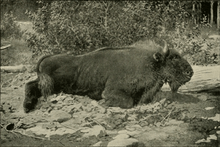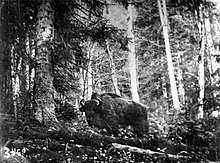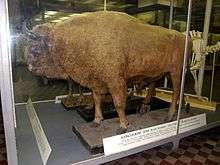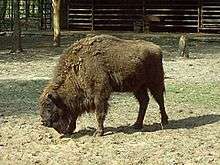Caucasian wisent
The Caucasian wisent (Bison bonasus caucasicus) or dombay (домбай)[2] was a subspecies of European bison that inhabited the Caucasus Mountains of Eastern Europe.
| Caucasian wisent | |
|---|---|
 | |
| An image of a killed Caucasian bison from E. Demidoff's book Hunting Trips in The Caucasus (1889) | |
| Scientific classification | |
| Kingdom: | Animalia |
| Phylum: | Chordata |
| Class: | Mammalia |
| Order: | Artiodactyla |
| Family: | Bovidae |
| Subfamily: | Bovinae |
| Genus: | Bison |
| Species: | |
| Subspecies: | B. b. caucasicus |
| Trinomial name | |
| Bison bonasus caucasicus (Turkin et Satunin, 1904) | |
Description

Along with Carpathian wisent, little is known about morphological details of these subspecies including body size due to extinction before modern scientific approaches were made.[2]
Comparared to the lowland wisent or the extant European bison, Caucasian bison was morphology more adapted to mountainous habitat.[2] Apparently, Caucasian wisent was generally smaller (there had been arguments regarding the Caucasian wisent to be smaller than the lowland bison, but most certainly less weighed), had shorter but higher hooves, had more developed shoulder girdles, had skulls similar in size to those found in Kuban region, had significantly thicker and larger horns, less shaggy coats, and curly hairs on head rear.[2][3][4]
Natural enemies
It was likely hunted by the Caspian tiger and the Asiatic lion (until the 10th century) in the Caucasus, as well as other predators such as wolves and bears although adult bulls wouldn't have normally been hunted, at least by wolves and bears, if similar to modern American bisons.[5]
Decline and extinction

In the 17th century, the Caucasian wisent still populated a large area of the Western Caucasus. After that human settlement in the mountains intensified and the range of the Caucasian wisent became reduced to about one tenth of its original range at the end of the 19th century. In the 1860s the population still numbered about 2,000, but was reduced to only 500-600 in 1917 and to only 50 in 1921.[6] Local poaching continued; finally, in 1927, the last three Caucasian wisent were killed.[7]
Hybrid survivors

Only one Caucasian wisent bull is known to have been kept in captivity. This bull, named Kaukasus, was born in the Caucasus Mountains in 1907 and brought to Germany in 1908 where he lived until 26 February 1925. While in captivity, he bred with cows from the lowland subspecies Bison bonasus bonasus.[8] Thus, he became one of the twelve ancestors of the present lowland-Caucasian breeding line of the European wisent pedigree book.[8]
Wisent reintroductions in the Caucasus
.jpg)
In 1940, a group of wisent-American bison hybrids were released into the Caucasian Biosphere Reserve and later in 1959 in the Nalchik Forestry Game Management Unit (Kabardino-Balkariya). Later some pure-blood wisent of the lowland-Caucasian breeding line were released there to form a single mixed herd together with the hybrids.[6]
In 2000, these hybrids were described as a different (without scientific basis) subspecies, the highland bison - Bison bonasus montanus (Polish).[9]
References
- Pucek; et al. (2004). "Bison bonasus". IUCN Red List of Threatened Species. 2004.CS1 maint: ref=harv (link)
- Semenov U.A. of WWF-Russia, 2014, "The Wisents of Karachay-Cherkessia", Proceedings of the Sochi National Park (8), pp.23–24, ISBN 978-5-87317-984-8, KMK Scientific Press
- Ninell Melkadze, Nargiza Ninua, Izabella Skhirtladze (2009): Catalogue of the type specimens of Caucasian large mammalian fauna in the collection of the National Museum of Georgia
- Daniel Foidl, 2013, Over-purity as a danger for the Wisent?, The Breeding-back blog, Tauros Programme
- Wolf–Bison Interactions in Yellowstone National Park
- Zablotskaya, Lidia V.; Zablotsky, Mikhail A.; Zablotskaya, Marina M. (26–30 September 1988). "Origin of the Hybrids of North American and European Bison in the Caucasus Mountains". Proceedings of the Second Conference of Bison Specialist Group. Sochi: SSC/IUCN.. Presented in Russian originally; translated into English in 1990, but never published in that form
- Bashkirov, I. S. (1939). "Caucasian European Bison". Moscow: Central Board for Reserves, Forest Parks and Zoological Gardens, Council of the People’s Commissars of the RSFSR: 1–72. Cite journal requires
|journal=(help) [In Russian.] - Puzek, Z.; et al. (2002). European Bison Bison bonasus: Current State of the Species and an Action Plan for Its Conservation. Bialowieza: Mammal Research Institute, Polish Academy of Sciences.
- Rautian, G. S.; Kalabushkin, B. A.; Nemtsev, A. S. (2000). "A New subspecies of the European Bison, Bison bonasus montanus ssp. nov". Doklady Biological Sciences. 375 (4): 563–567. doi:10.1023/A:1026658309135. PMID 11211514.
